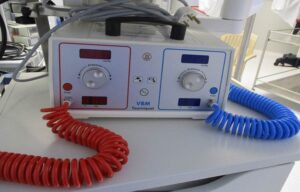A tourniquet machine is a medical device used to apply and control the pressure of a tourniquet during surgical procedures. It is an advanced technology designed to provide accurate and consistent pressure, minimizing the risk of complications such as nerve damage or tissue necrosis.
Tourniquet machines come in various forms, but they generally consist of a cuff that is placed around the patient’s limb, a compressor unit that inflates the cuff, and a control panel that allows the surgeon or anesthesiologist to set and monitor the pressure levels.
Benefits of Tourniquet machine
One of the main benefits of using a tourniquet machine is the ability to precisely control the pressure and duration of the tourniquet. This is especially important during longer surgeries, as the pressure can be adjusted as needed to avoid tissue damage or nerve compression.
Another advantage of using a tourniquet machine is the ability to monitor the patient’s vital signs and blood flow during the procedure. The machine can be equipped with sensors to measure blood pressure, oxygen saturation levels, and other important parameters, allowing healthcare professionals to closely monitor the patient’s condition and adjust the tourniquet pressure as needed.
Using a tourniquet machine can also help to reduce the risk of complications associated with traditional tourniquet application, such as uneven pressure distribution, cuff slippage, or unintentional release of the tourniquet.
In addition to their use in surgical procedures, tourniquet machines can also be used in emergency medical settings, such as in the management of traumatic injuries. They can help to quickly and effectively control bleeding, minimizing the risk of blood loss and improving patient outcomes.
Conclusion
In summary, tourniquet machines are advanced medical devices that can help to improve the safety and effectiveness of tourniquet applications during surgical procedures. They offer precise control over pressure levels, can be equipped with sensors to monitor patient vital signs, and can help to minimize the risk of complications associated with traditional tourniquet applications.